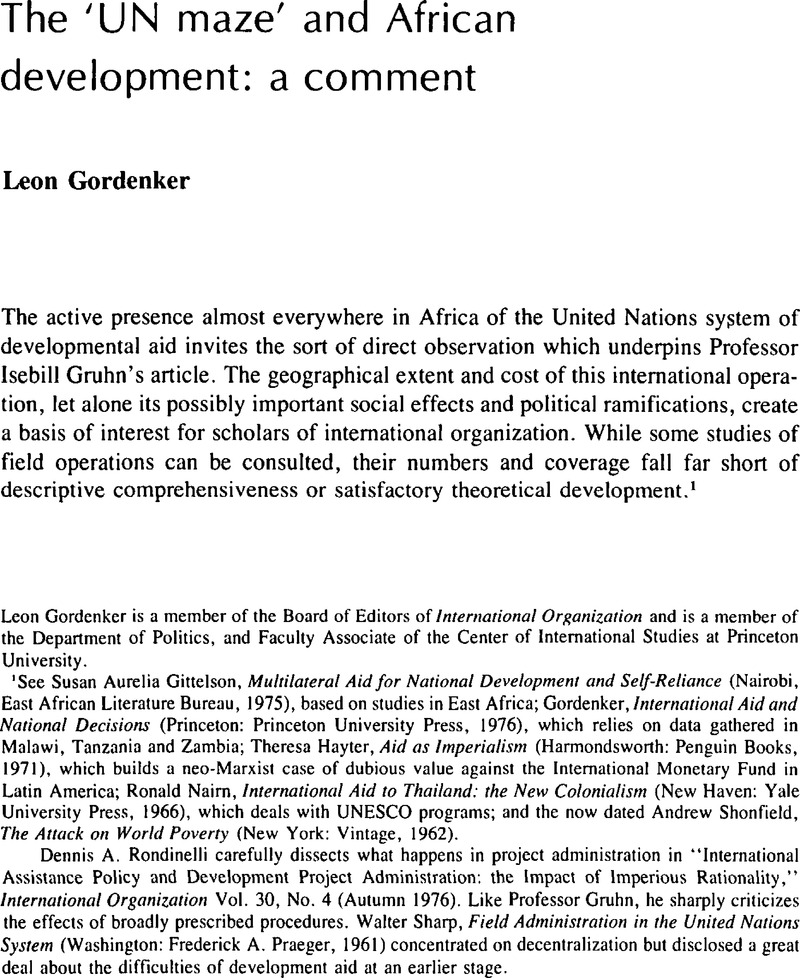No CrossRef data available.
Article contents
The ‘UN maze’ and African development: a comment
Published online by Cambridge University Press: 22 May 2009
Abstract

- Type
- Symposium
- Information
- Copyright
- Copyright © The IO Foundation 1978
References
1 See Gittelson, Susan Aurelia, Multilateral Aid for National Development and Self-Reliance (Nairobi, East African Literature Bureau, 1975), based on studies in East AfricaGoogle Scholar; Gordenker, , International Aid and National Decisions (Princeton: Princeton University Press, 1976),Google Scholar which relies on data gathered in Malawi, , Zambia, Tanzania and; Hayter, Theresa, Aid as Imperialism (Harmondsworth: Penguin Books, 1971)Google Scholar, which builds a neo-Marxist case of dubious value against the International Monetary Fund in Latin America; Nairn, Ronald, International Aid to Thailand: the New Colonialism (New Haven: Yale University Press, 1966)Google Scholar, which deals with UNESCO programs; and the now dated Shonfield, Andrew, The Attack on World Poverty (New York: Vintage, 1962)Google Scholar. Rondinelli, Dennis A. carefully dissects what happens in project administration in “International Assistance Policy and Development Project Administration: the Impact of Imperious Rationality,” International Organization Vol. 30, No. 4 (Autumn 1976)CrossRefGoogle Scholar. Like Professor Gruhn, he sharply criticizes the effects of broadly prescribed procedures. Sharp, Walter, Field Administration in the United Nations System (Washington: Frederick A. Praeger, 1961)Google Scholar concentrated on decentralization but disclosed a great deal about the difficulties of development aid at an earlier stage.
2 Details of one such shift on a river valleys project in Tanzania can be found in Gordenker, pp. 97–111. Research in other places would doubtless turn up many more such examples.
3 Sir Robert Jackson left no doubt of his view. “For many years, I have looked for the ‘brain’ which guides the policies and operations of the UN development system…there is no group (or ‘Brain Trust’) which is constantly monitoring the present operation, learning from experience…” United Nations, A Study of the Capacity of the United Nations Development System, Vol. 1, UN Doc. DP/5 (Geneva: 1969), p. 13Google Scholar. Hereafter cited as Jackson Report.
4 The Jackson Report also emphasized the importance of getting free of administrative corsets, but in the end it advocates a highly rationalized approach, replete with central planning. Vol. 1, pp. 25–31.
5 These certainly are not the only projects which UNDP believes successful and most projects obviously are less extensive. See United Nations Development Programme, Why What How Where (New York, UNDP, n.d.)Google ScholarPubMed, passim.
6 Gordenker, pp. 111–18. I do not advocate the abrupt, authoritarian style used by President Banda as a general remedy.
7 Vol. 1, pp. 29–31.
8 An inherent danger in developmental aid is that it will contribute to the ability of the recipient government to oppress its own people. Such oppression could accompany significant economic development. To avoid such doings, donor countries would have not only to exercise special vigilance but would also have to give commitments to international organization far beyond any so far offered.


